A new graphene-based nanoscale sensor enables detection of a single carbon dioxide molecule - Breakthrough for future environmental sensing technology
| Key features: | ||
|
||
|
A research group at School of Materials Science / Energy and Environment division at Japan Advanced Institute of Science and Technology (JAIST, President Testuo Asano), succeeded to detect a single CO2 molecule electronically by using a newly developed nano-scale sensor device with a suspended graphene, which will have major implications for future environmental sensing and monitoring technologies. In recent years, health problems due to air pollution in the personal living space are getting serious as represented by sick building syndrome (SBS). Very dilute chemical gas molecules such as volatile organic compounds (VOC) originated from building and interior materials, furniture and even from daily commodities adversely affect us living in modern houses with good insulation. Sick car and sick school syndromes have also become issues recently. Over one million patients presumably suffer from those syndromes in Japan. However, those harmful chemical gases are very dilute with concentration of low ppb (parts per billion) level and it is extremely difficult to detect with the current gas sensor technology. A research group of Prof. Hiroshi Mizuta, Dr. Jian Sun and Assistant Prof. Manoharan Muruganathan at JAIST successfully developed a novel principle to detect individual CO2 molecules adsorbed onto the suspended graphene (single atomic sheet of carbon atoms arranged in a honeycomb-like hexagonal crystal lattice structure) one by one electronically. Even under a very dilute gas environment equivalent to the ppb level, high-speed molecule detection is achieved by accelerating the gas molecules adsorption onto graphene by applying an electric field. By using NEMS (nano-electro-mechanical systems) fabrication technology, a doubly-clamped suspended bilayer graphene beam was built on a semiconductor substrate. By applying an electric field from the substrate, few CO2 gas molecules were drawn and adsorbed onto the graphene beam. By monitoring the electrical resistance of the graphene beam, the adsorption and desorption processes of individual CO2 molecules onto the graphene were detected as 'quantized' changes in resistance (step-wise increase or decrease in resistance). In the present demonstration, a very small volume of CO2 gas introduced in this demonstration is equivalent to the concentration of approximately 30 ppb, and the detection time was only few minutes. In contrast to the commercially available environmental monitoring tools, this extreme sensing technology enables to realize significant miniaturization, weight and cost reduction in addition to a remarkable improvement in the detection limit from the ppm levels to ppb levels. The technical details of the present work was reported on 15th April in the online edition of "Science Advances" journal of the American Association for the Advancement of Science (AAAS). In addition, the physical mechanism of single-molecule detection was published online on 12th November, 2015 in the "Nano Letters" journal of American Chemical Society (ACS). |
||
|
The research Project details: |
||
| Purpose and Background: | |||
|
The atomic layer material graphene features the Young's modulus (coefficient of elasticity of a substance) one order of magnitude higher than that for silicon in addition to its excellent electrical properties. Also, graphene can withstand about 20% of the lattice deformation against tensile stress, which makes it as an attractive candidate to nano-electro-mechanical systems (NEMS). Furthermore, it has the highest surface-to-volume ratio, which is a very important requirement for the high sensitivity sensor. In 2013, the research group led by Prof. Hiroshi Mizuta started the project "Development of Graphene NEMS hybrid functional devices for autonomous and ultrasensitive integrated sensors" aiming at ultra-high sensitivity environmental sensors, and low power management, funded by Japan Grant-in-Aid for Scientific Research (KAKENHI) (S). In recent years, sick building syndrome (SBS) has become a serious health issue associated with personal living space air pollution caused by very dilute chemical gas molecules such as volatile organic compounds (VOC) released from new building & interior materials, furniture and even daily commodities in modern houses with good insulation. In general, these harmful chemical gases are very dilute with concentration of low ppb (parts per billion) level, and it is extremely difficult to detect them with conventional gas sensing apparatus. We successfully achieved electrical detection of single CO2 molecule for the first time in the world by combining a newly developed graphene NEMS fabrication technology and atomistic simulation to elucidate the microscopic mechanism of molecular interaction with graphene at the atomic level. |
|||
| Present achievements: | |||
|
Using our unique graphene NEMS fabrication techniques, a doubly clamped bilayer graphene beam was first fabricated and then by applying a voltage to the lower gold electrode the graphene beam was electrostatically pulled down (Figure 1 (a-b)). By introducing very dilute CO2 gas into the measurement chamber, the temporal variation of electrical resistance was monitored for the sloped graphene beam. No change in the resistance was noticed under zero substrate electric field (Fig. 2b Black curve). However, the molecular adsorption rate was accelerated with an external electric field to the graphene device by applying the backgate voltage to the substrate, which leads to slight polarization of CO2 molecules. These weakly polarized molecules are attracted towards the regions of strong electrostatic potential zone enveloping the graphene surface (Fig. 3, Top right). This is clearly noticed from the quantized values of resistance increase or decreases for CO2 molecule adsorption or desorption, respectively (Fig. 2b, Blue and Red curves). Atomistic simulations with high precision van der Waals interaction model revealed that CO2 molecules are physisorbed on graphene with ~3 Å gap, and slight charge transfer occurred between graphene and CO2 molecule. A very small volume of CO2 gas was introduced into the measurement chamber with concentration equivalent to the approximately 30 ppb, and within a few minutes these molecules were detected. Furthermore, physisorbed molecules move away from the graphene beam when we turn off the electric field. This detection method is favored as negligibly small damage is given to the sensor with a repetitive use and therefore its life time is extended. This newly developed graphene sensing technology gives remarkable improvement in the detection limit from the ppm levels for the conventional gas monitoring tools to the ppb levels, along with the possibility of remarkable miniaturization, weight and cost reduction. |
|||
| Future plan: | |||
|
In the present work, we employed CO2 molecules, which are known for very poor doping capability for gprahene and therefore hard to detect. Various volatile organic compound gas molecules such as formaldehyde, benzene, etc, the causes for the sick house syndrome, will be employed as target molecules in the next step of experiment (Fig. 4). In order to enhance the sensitivity and detection speed further, additional improvements will be performed such as reducing the width of the graphene beam to single nanometers (less than 10 nanometers), optimization of the graphene NEMS structure and the electric field strength applied from the substrate. Moreover, the graphene NEMS switch, which is also under development in parallel to the graphene sensors in the current project, will be co-integrated with the sensor circuits in order to reduce the power consumption remarkably and prolong the battery lifetime. |
|||
| Glossary: | |||
|
|||
| Reference Figures: |
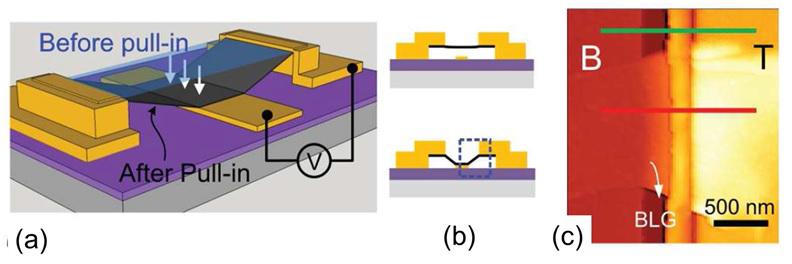 Fig. 1 (a) Schematic diagram of pulling down a suspended graphene with electrostatic force onto the bottom electrode. (b) Side-views before and after pull-in of the graphene beam. (c) AFM image of the suspended bilayer graphene (BLG) device. Red line: GNEMS region; Green line: Top (T) and Bottom (B) electrodes region without graphene. |
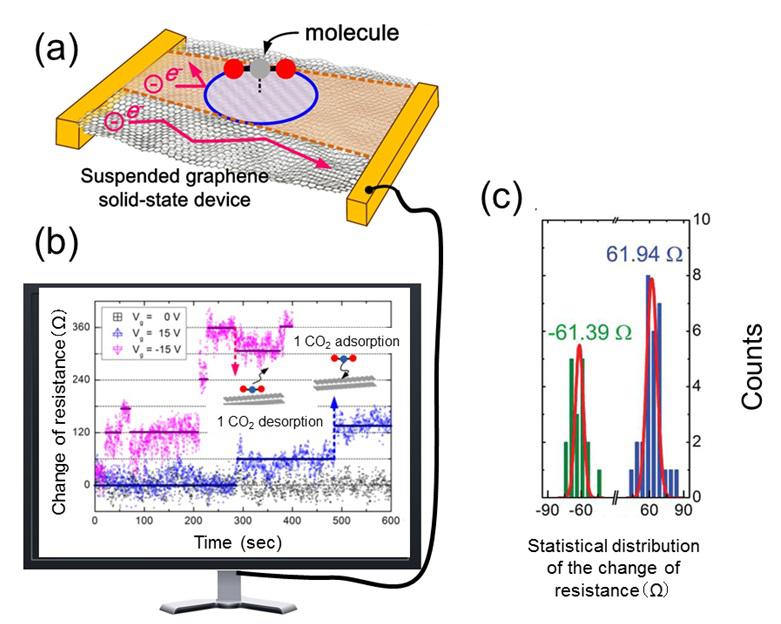 Fig. 2 (a) Schematic diagram illustrating a graphene beam partial conducting channel shut-off due to a CO2 molecules adsorption, (b) Measured time-dependent change in electric graphene beam resistance change (Black dots: without any substrate voltage; Blue dots: Positive substrate voltage; Pink dots: The case of negative substrate voltage applied), (c) The statistical distribution of the change in electrical resistance indicating "quantization of the resistance change". |
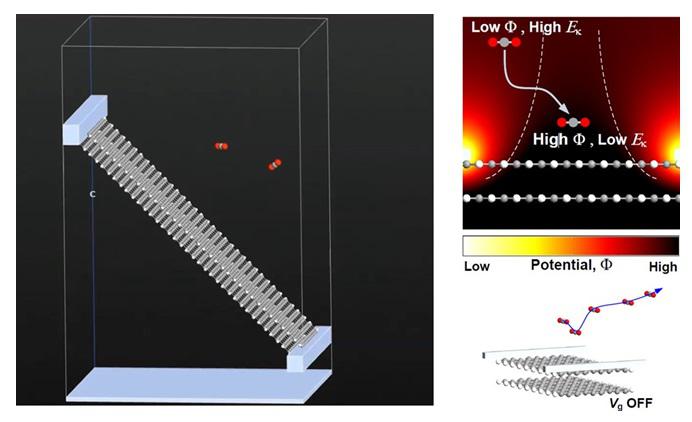 Fig. 3 Molecular dynamics simulation of CO2 molecule motion over the bilayer graphene beam surface (Left). The potential distribution at the graphene surface with the application of backgate voltage. The area with high potential is between the two dashed lines (Top Right). The molecular dynamic simulation of the trajectory of a free CO2 molecule near the graphene surface without Vg. The arrow lines give the trajectory of the molecule (Bottom Right). |
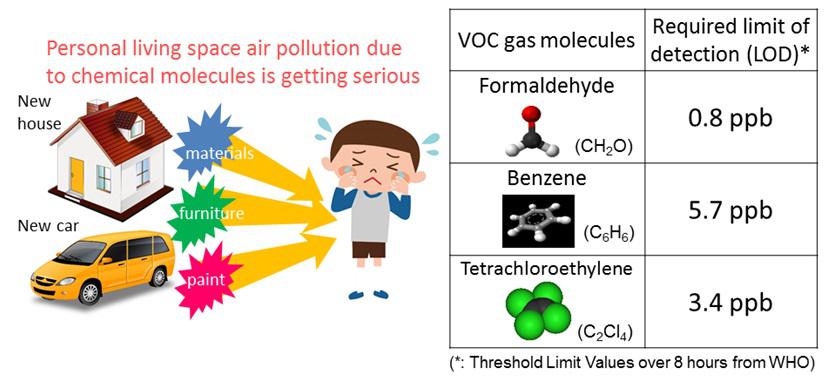 Fig. 4 Sick building syndrome (SBS): Release of Volatile Organic Compound gas molecules from the house, furniture and car. Table of VOC molecules Vs Required Threshold detection limit values over 8 hours from WHO. |
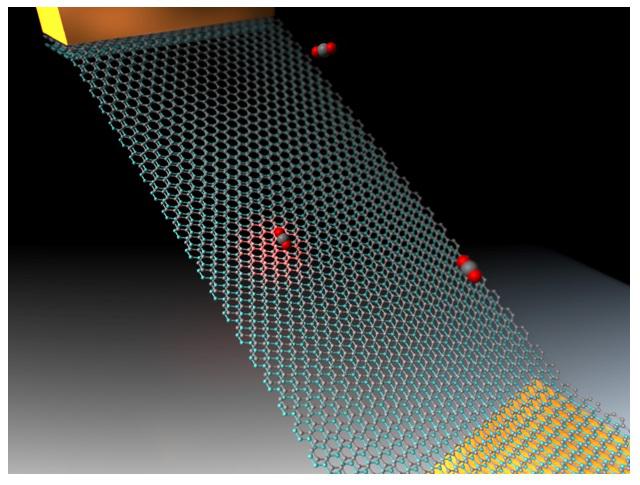 Fig. 5 Artwork showing the single molecule detection |
April 18 ,2016
Press Release contact:
Public Relationship office,
Japan Advanced Institute of Science and Technology 1-1, Asahidai, Nomi, Ishikawa, 923-1211
Tel :0761-51-1031
Fax:0761-51-1025
E-mail:kouhou@ml.jaist.ac.jp
